Beginning note: It is the first wine that I actually dreamed about. Far before I could actually afford it, I bought it and didn’t stop until I had a pretty good vertical (and a much lighter wallet) that was just added to each vintage. It was the wine I reached for when the company I worked for was sold to another company, sending my family from one end of the country to the other for a new job. It has brought me great joy.
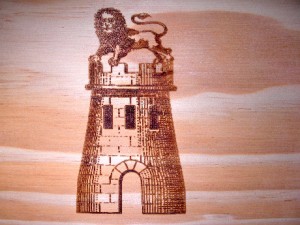
Chateau Latour has been like a good friend through the good times and the bad. The one wine that I can truly say is my proverbial deserted island wine. And even though I have stopped collecting Latour, and, in fact, don’t have even one bottle left (that’s another story), it doesn’t lessen the fact that I remain (and always will) totally head-over-heels infatuated with it.
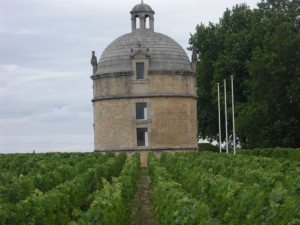
And so it was, with giddy anticipation and excitement that a trip to Bordeaux included an extensive tour and tasting of Latour, that hallowed ground in Pauillac, God’s greatest patch of terroir on the planet. And I loved every second of it.
By Rick VanSickle
PAUILLAC, Bordeaux — It is at once both awe-inspiring and troubling.
I’m talking about the tower, of course, a powerful symbol of both the history of Bordeaux and Chateau Latour in particular. It is the tower that adorns each and every bottle of the chateau’s Grand Vin and easily the most recognizable label in the world.
But it is not what you see when you reach the sprawling estate, on the south-east tip of Pauillac, a stone’s throw away from the Gironde Estuary.
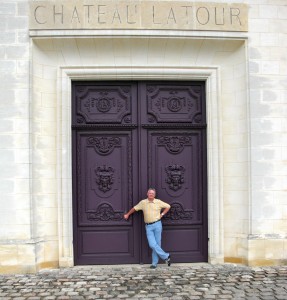
What you do see, jutting out rather majestically from the vineyards, is a pigeon house tower built in the 1620s which has become the modern emblem of the chateau, reminiscent of centuries gone by when Aquitaine needed protection from invading armies.
The original tower, the one made famous on the label, called the Tower of St. Lambert, was built as a fortress during the Hundred Years War around 1331.
Chateau Latour emerged in 1378 during the peak of the Hundred Years War when the Anglo-Gascon army established a fortress on the site.
The Tower of St. Lambert was burned to the ground in the 1450s and, of course, no longer exists. The pigeon house tower was built in its place and that is what you see when drive through the gates of the estate today.
Still powerful, but no matter how many times you see pictures of it, you half expect it to look a little bit like the label. And it just doesn’t.
•••
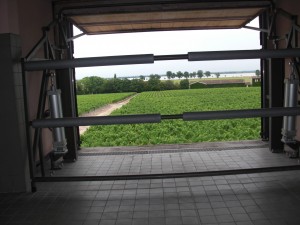
Chateau Latour is located in the famous Medoc wine region, about 40 kms northwest of the city of Bordeaux in the high-rent appellation of Pauillac. It is here that terroir, the perfect combination of grapes, geography, geology and climate come together like nowhere else.
The estate consists of 78 ha of vineyards. The 47 ha surrounding the chateau, the heart of the estate, are called l’Enclos. Only the grapes from these 47 ha make it into the Grand Vin de Chateau Latour.
L’Enlos has a typical Medoc topography, with a gentle rise in the ground, bounded on the north and south by two small streams, and on the east by the palus, the low lying meadows by the river. But this enclos benefits from a very unique terroir that combines an optimized sub-soil nutrition for the vines, the Gironde River which tempers extreme weather conditions, and a typical Medoc climate, largely influenced by the Atlantic ocean, which allows the grapes to reach maturation under favourable conditions.
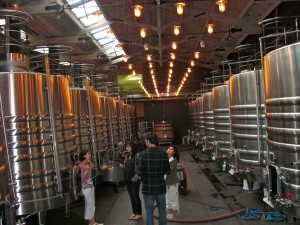
This combination determines the personality and the characteristics of Chateau Latour. It also imposes, almost naturally, a selective choice of grape varieties: Cabernet Sauvignon (80%), Merlot (18%) and Cabernet Franc and Petit Verdot.
Latour’s wines are referred to by many as quintessential claret. They are defined by their elegance, intensity and smooth mouth feel. The tannic backbone gives the wines their longevity in the cellar.
Typical flavours include blackberries, currants, vanilla, spice and wonderful minerals that help define this magnificent wine.
•••
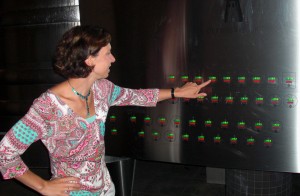
You cannot just walk up to Chateau Latour and be taken on a tour. Like most top estates in Bordeaux, it seems they didn’t get the memo sent around to wineries in Napa Valley and other regions that have an open door policy.
For a tour of Latour you must apply to the winery and be accepted. It is not a given that you will be granted a tour and tasting of one of the world’s most expensive wines. Our invitation was arranged by Neal McLenna, associate editor of the Vancouver based Western Living Magazine, who had made plans weeks in advance of our visit and was facilitated by our hosts from Vin de Bordeaux. They were expecting us and had blocked out 45 minutes of precious Latour face time for us.
Neal was greeted with a big smile and got the Mr. treatment while the rest of us, two other wine-food journalists and our guide, got to tag along.
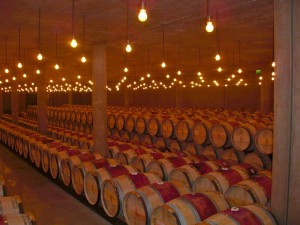
The winery at Latour is a sprawling, high-tech, modern-day wonder. It is spotlessly clean, efficient and spacious. Even our guide fits in with the architecture; attractive, chic and all business as she checks us in and we embark on a quick guided tour.
We start at the logical beginning of the process, in the “cuvier†(vathouse) where the harvested grapes are hoisted to be destemmed and crushed. The juice, pips and skins are then lightly pumped into the fermentation vats, 66 different vats from 66 different blocks of vines, following three criteria: geographical parcel origin, the age of the vines and the grape varieties.
All the grapes brought into the winery are hand-picked and hard-sorted before crushing. Fermentation takes about a week while maceration (with skins and pips) lasts another three weeks.
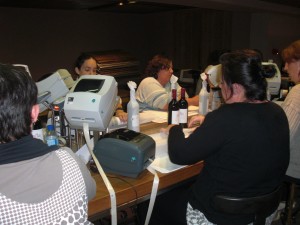
All the stainless steel vats are thermostatically controlled with a huge control panel that watches over each vat and can be adjusted individually.
After four weeks, the wine is separated from the skins and returned to the vats to undergo malolactic fermentation to give the wine a rounder, more supple feel in the mouth.
After fermentation, the winemakers hold frequent tastings to decide the final destination of each vat and which will go into the three wines made at Latour: Chateau Latour, Les Forts de Latour or the generic Pauillac. The wine is finally drawn off into 100% new oak casks (1,000 barrels) in December. The wines are matured for about 18 months. All one-year-old barrels are sold each year to other wineries.
Finally, during the course of the following winter, the wine is fined with egg whites (there is no filtration at Latour).
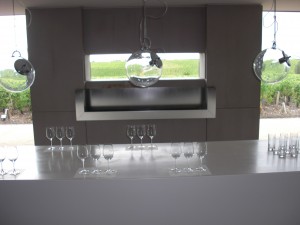
One month before bottling, the wine undergoes its last racking and is then transferred into vats, where the final blending will take place before bottling.
Bottling of the wines is determined by constant tastings. The wine can remain in cask for up to 18 months while waiting for it to shed its youthful vigour while maintaining richness.
The capsuling, labelling and packing in wooden cases is done immediately prior to being shipped, thus ensuring an impeccable presentation. All bottles are wrapped by a fine white tissue paper, and marked with a special code to prevent fake wines from reaching the market. The process takes about two months.
•••
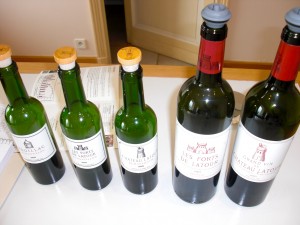
We are guided into our final stop along the tour, an immaculate tasting room that looks out into the most famous vineyards in the world. We had a warm, glowing feeling before even tasting the wines put in front of us.
The magnitude of the 2009 vintage had us giddy with anticipation as our guide poured us five wines spread out neatly on tasting sheet.
Here’s what we tasted:
The Pauillac 2009 — The grapes for this “generic†Pauillac are generally from young vines from the three plots situated outside the Grand l’Enclos. It can be considered the third wine of Chateau Latour and is composed of 54% Cabernet Sauvignon and 46% Merlot and represents about 16% (50,000 bottles) of production at Latour.
Our barrel sample had wonderful aromatics of wild berries, vanilla and firm oak tones. In the mouth it showed rich black fruits, youthful power and tannic structure.
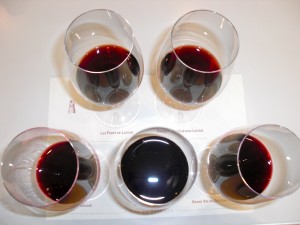
Les Forts de Latour 2009 ($209 a bottle, futures price) — This famous second wine of Latour is made with the grapes from the young vines, less than 12 years old, and may contain declassified wine from the Grand Vin. But, like it’s big brother, this is a serious wine that is sold en primeur just like other classified Bordeaux. The production is 150,000 bottles and is comprised of 61.5% Cab Sauv, 32.3% Merlot and the rest Petit Verdot.
The nose is extremely tight from the barrel sample but is a deep purple colour with aromas of oak, crushed black fruits, mineral and a nice smoky nuance. It shows its teeth on the palate with an explosion of black fruit flavours, oak tones, spice and power. Built to last for decades in the cellar.
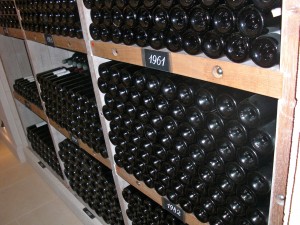
Chateau Latour 2009 ($1,395 a bottle, futures price) — By now we have all heard of the 2009 vintage in Bordeaux. Some say it the best vintage in 30 years in Bordeaux. It’s certainly got collectors wagging their tails with the highest “future†prices ever paid for a vintage. The 09 Latour just may well turn out to be the wine of the vintage. It is a monster.
The blend is 91.3% Cabernet Sauvignon and the rest Merlot. Production is 120,000 bottles with an unusually large alcohol content of 13.7%. There are predictions that this super-concentrated wine will survive 100 or more years in bottle. Think about that! 100 years. Wow.
Certainly, based on colour alone, an opaque, inky, purple colour, it looks visually stunning. The aromas come rushing at you — sweet currants, blackberry, cocoa, oak, layers of stony minerality, and spice. It is enthralling on the palate, even at this stage from barrel, with a powerful frame, highly-extracted black fruits, layered, textured and built on pure power. A monumental wine, to be sure, and such a privilege to have tasted it.
•••
We left the tasting room, our teeth black from barrel sampling some of the world’s greatest wines (we also tasted the 2003 Latour and the 2005 Les Forts de Latour), with a warm, glowing feeling. We toured the grounds a bit, savouring our magical 45 minutes of pure wine bliss. And, yes, took some touristy shots outside the big purple doors of Chateau Latour.
It was dream to visit Latour. And now it is a sweet, sweet memory.


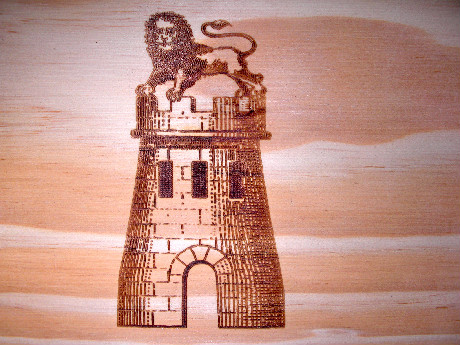




Comment here